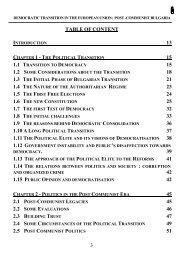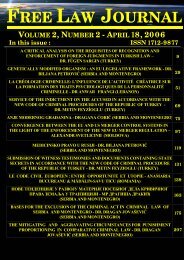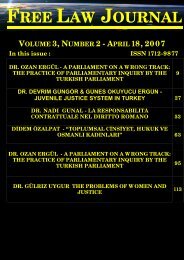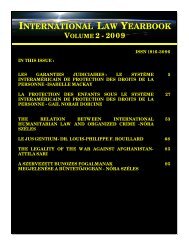Free_Law_Journal-Vol.. - Free World Publishing Inc.
Free_Law_Journal-Vol.. - Free World Publishing Inc.
Free_Law_Journal-Vol.. - Free World Publishing Inc.
You also want an ePaper? Increase the reach of your titles
YUMPU automatically turns print PDFs into web optimized ePapers that Google loves.
FREE LAW JOURNAL - VOLUME 1, NUMBER 1 (18 JULY 2005)<br />
on the same contentious issue. The plaintiff brings an actio redhibitoria about a fault on the good he<br />
bought, but then he is cast in the action. It will be against bis de eadem re ne sit actio principle, if he<br />
wants to bring an actio quanti minoris this time, against the same defendant about the same fault on the<br />
same good. Because, the subject of the first action (actio redhibitoria) and the second action (actio quanti<br />
minoris) are the same 55 . But, bis de eadem re ne sit actio principle is not applied to cases where, after<br />
being cast in an actio rei persecutoriae the plaintiff brings an actio poenales against the same defendant<br />
about the same subject. Even though in Roman law, like the rest of the criminal actions and compensation<br />
actions, actio rei persecutoriae and actio poenales aim the same purpose, they are not accepted as “same<br />
actions”. Because the characteristics of both these actions are different. If the plaintiff, after being cast in<br />
the actio furti, brings a condictio furtiva against the same defendant about the same subject, or the<br />
contrary, he does not encounter any legal obstacles. In the same way, the plaintiff’s bringing a actio furti<br />
after rei vindicatio which he has lost, is not against bis de eadem re ne sit actio principle 56 .<br />
When all these explanations are taken into considerations, it would be hard to say that eadem res can only<br />
be determined when the litis contestatio phase of the action is completed. However, it would be more<br />
accurate to say eadem res is determined by also considering the definite judgement given by the court 57 .<br />
As we said before, joinder of issue phase of the action plays an important role especially in Roman<br />
classical law period. But surely, this does not mean that the judgements given by courts are ineffective. In<br />
fact, definite judgement is so effective that existence of second judgement about one subject, not only<br />
harm the interests of the parties of the action but also the public benefit. This perspective in late Roman<br />
law forms the basis of the concept of definite judgement of current times 58 .<br />
In formulary procedure, appeal is not known. The decision given by the judge at the end of the action is<br />
definite and considered as the fact. But even the best judges can make mistakes. If a judge, makes a<br />
mistake on the basis of formulary procedure, the judgement is considered as not existing. For example, if<br />
the plaintiff or the defendant does not have the capability of being a side in an action, because he is<br />
mentally ill or because of some other reasons, or the judgement is given without listening one side, it is<br />
accepted that no judgement exists 59 . In such cases, the plaintiff can bring an action once again without<br />
encountering any legal obstacles, because there is no definite judgement about this contentious issue. If<br />
the first action ends in favour of the plaintiff, the defendant can claim that no judgement exists in an<br />
execution action which has brought by the plaintiff. But in Roman law and especially in formulary<br />
54 Berger, p. 67; Actio quanti minoris, is an action brought before the court for reduction of the payment. This action is also called as<br />
actio aestimatoria. The salesman is responsible for the physical faults only in horse and slave sales in Roman classical law period and<br />
in all kinds of goods in Justinian period. Actio quanti minoris is an action granted to the purchaser by aedilis curulis, to bring against<br />
the salesman for reduction of the payment because of the damages caused by the physical faults in the thing. This action can be<br />
brought before the court in one year and salesman is held responsible for the faults that he is not aware of.<br />
55 Provera, p. 25; D. 44, 2, 25, 1.<br />
56 Sohm, R.; The Institutes: A Textbook of the History and System of Roman Private <strong>Law</strong>, Transl. by J. C. Ledlie, 3. Ed., New<br />
Jersey, 1970, p. 445; In actions related closely to public order like status actions, the judgement given by the court, binds<br />
everybody (D. 1, 5, 25).<br />
57 Provera, p. 25.<br />
58 Pugliese, (Action), p. 427; Tahiroglu/ Erdogmus, (Procedure), p. 18 sq.; In formulary procedure, like legis actiones<br />
procedure, slaves do not have a capability of being side in actions. But some changes are occurred in the status of filius<br />
familias. They can be put in the position of defendant for the legal relation that they have taken in part. Women have a limited<br />
capability of being a side in actions about their own matters. In formulary procedure, foreigners gained the capability of being<br />
side in actions. Also in this procedure, it is necessary for people who do not have the capability of being side in actions to be<br />
represented, in actions related with them.<br />
59 Wenger, p. 211; (D. 49, 1, 19; C. 1, 21, 3; C. 2, 10, 3; C. 7, 52, 2).<br />
GOKCE TURKOGLU-OZDEMIR - “BIS DE EADEM RE NE SIT ACTIO” PRINCIPLE IN THE FORMULARY SYSTEM OF ROMAN LAW OF PROCEDURE 148
















